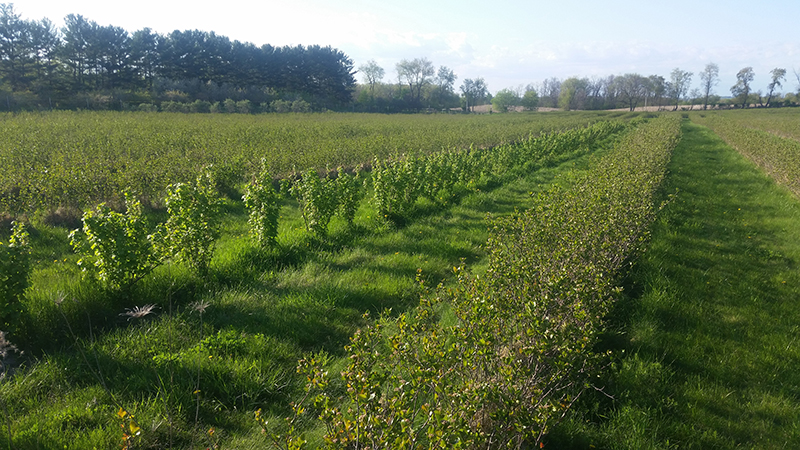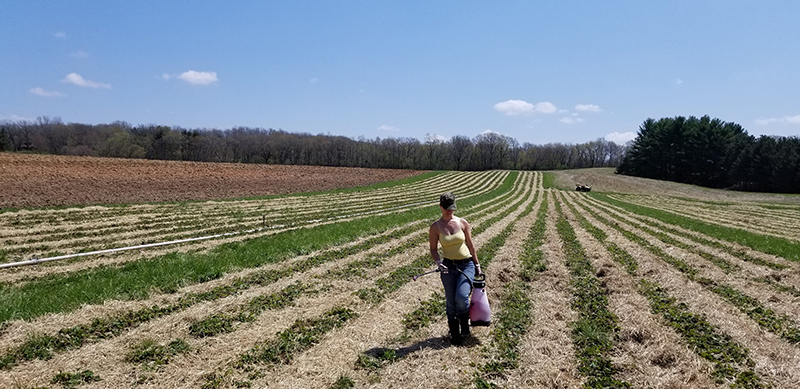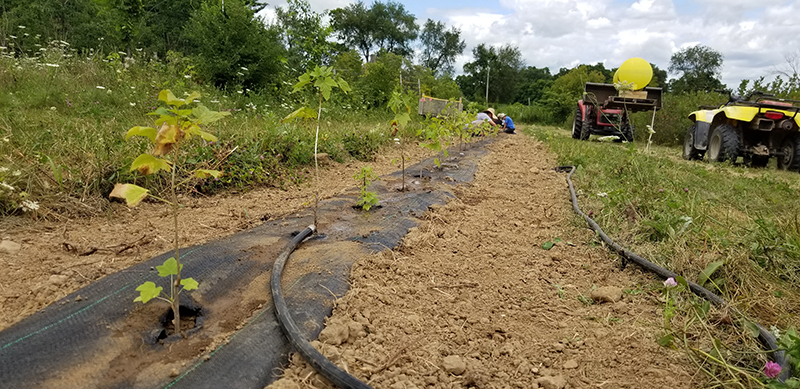As consumers, we’re bombarded with information that aims to identify what makes a product unique. Product labels are full of marketing and regulatory terms that are intended to inform and provide value to the product. They provide the producer an opportunity to differentiate their product from similar products. The information can be helpful but it can also be confusing, and maybe a bit overwhelming: what does it all mean?
In the Produce departments at Willy Street Co-op, we try to keep our labeling clear and simple. Products that are USDA-certified organic are labeled as Organic. If products meet our local definition (within 150 miles of the state capitol building or anywhere in Wisconsin), they’re labeled as Local, regardless of whether they are organic or not.
One thing we don’t talk much about is Integrated Pest Management. At a local level, most of the farms we work with are USDA-certified organic. Over the years, we’ve established relationships with other local growers as an effort to provide local products that we’ve had difficulty sourcing from organic growers, either they weren’t growing it at all, or their volume was better suited for farmers markets or CSA shares. For any number of reasons, producing enough volume to support a wholesale account was a challenge. But for many farmers, the primary reason was that it was just too difficult to grow using exclusively organic practices; it just wasn’t practical in our upper midwest climate. So, we went looking for local sources that weren’t certified organic, but were using practices that supported a high level of sustainability. And this is where integrated pest management comes into play.
The IPM Institute (located right here in Madison), works with a number of organizations, agencies, and industry members to develop and implement programs that incorporate IPM standards. They define integrated pest management as a sustainable, science-based, decision-making process that combines biological, cultural, physical, and chemical tools to identify, manage and reduce risk from pests and pest management tools and strategies in a way that minimizes overall economic, health, and environmental risks.
(Article continues below photos.)






Carandale Fruit Farm in Oregon, Wisconsin, has crops that are USDA-certified organic, and crops that are not certified organic, but where they use IPM strategies. They grow a variety of tree fruits and berries at the farm and supply Willy Street Co-op with Fredonia and Concord grapes, and aronia berries. I reached out to Cory at Carandale and asked why they chose to incorporate both practices on the farm.
“I think to answer the question as to why we use both IPM and organic management practices, we must first assess our intent as well as the crop being grown. In addition, please understand that being a certified organic crop does not exclude it from also being managed with IPM principles, as they are not mutually exclusive. The organic movement prohibits all man-made compounds and allows only natural fertilizer and pesticides; over time this distinction has become somewhat blurred, but is still the philosophical basis in approving substances for use in organic farming.
“IPM spans beyond conventional versus organic farming; it is incorporating the philosophies of different cultural practices including, but not limited to, rotating chemical modes, crop rotations, use of cover crops, preserving beneficial insects, windbreaks/grass strips, timing, and good old-fashioned time and effort monitoring crops for specific location and population thresholds. Agriculture is always most sustainable when the widest possible range of production tools can be used. So at Carandale Farm we incorporate these IPM concepts into ALL our cultural efforts… regardless if organic or conventional. The deciding factor regarding certifying a crop organic is based on the crop itself, its characteristics, and the region in which it is being grown.
We decided to grow our strawberries using IPM principals because fleshy fruits can/do readily absorb water/chemicals that come into contact with them. So reducing any/all chemical applications is our intent with strawberries so as to reduce overall residual ppm (parts per million) of chemical absorbed by the berry/plants and into the environment. So why can IPM reduce chemical loading more than organic practices alone? In general organic chemicals have much less residual/persistence and must be reapplied more frequently to maintain their desired effects/controls… thus more chemical applications to maintain the desired effect over time.
“IPM allows us to use many other tools as stated above. We can use chemicals (often organic, if appropriate) in the areas in which the infestation or encroachment is happening… so when using IPM we spend a large amount of time monitoring to isolate those areas of concern and stop issues before they affect the entire area. For example, if I do proper crop monitoring I can often get away with ONLY spraying the edge 5 rows instead of the entire field(s). If pesticides are needed, they are selected on the basis of least toxicity and timed or applied in a manner that eliminates or minimizes contact with fruit and beneficial insects.
“That being said, we chose to go organic with our aronia berry, black currants, and other various woody perennials because they are less prone to certain diseases and insect issues in their native area (Wisconsin), and our IPM practices in/around the crops have proven [their] effectiveness. So in short, we chose which crop we can grow safely as organic–based on our intent–by knowing the local probability of insect and disease issues associated with that crop.”
Blue Roof Orchard in Belmont, WI, supplies Willy Street Co-op with a variety of delicious certified organic local apples. I reached out to Chris at Blue Roof, and asked if he could identify IPM practices they incorporate as part of their organic strategy.
“In our certified organic apple orchard we primarily grow apple varieties that have innate resistance to destructive diseases of apples such as apple scab. Apple scab is a fungus that infects apple trees and can cause spots on the apple leaves, as well as large black spots and cracking on the fruit. Like many plant diseases, scab is favored by wet weather such as we have had this spring—the fungus can only penetrate and infect leaves and fruit when they are wet. Scab is an extremely destructive disease, not merely a “cosmetic” issue—scab-infected leaves will drop from trees, causing premature defoliation and major reductions in yield. Scab is especially difficult to manage in organic orchards; non-organic growers typically spray chemical fungicides in spring to control the disease.
“In human medicine, we’re increasingly aware that people have different genetic susceptibility to conditions such as heart disease and cancer. Similarly, apple varieties genetically vary in their susceptibility to attack by the apple scab fungus. McIntosh and Cortland apples, for example, are notoriously susceptible to scab. As a first line of defense against this disease, we’ve primarily planted apple varieties that have strong genetic resistance to scab, such as Winecrisp and Liberty apples. As an additional defense, we are also careful to mow the fallen leaves on our orchard floor several times in very early spring. The apple scab fungus actually survives the winter on fallen, dead leaves, not on the tree itself, and by shredding and destroying leaves after the snow melts we reduce the likelihood that scab fungi living in the dead leaves will produce spores that can re-infect the trees in spring.”
Barnard Farm in Sturgeon Bay, WI, supplies Willy Street Co-op with their incredible sweet cherries and peaches! Jim started working with fruit in 1960 in his parents’ orchard, and started his orchard in 1974. You can find Jim and his daughter Susan at the Dane County Farmers’ Market, and their delicious local fruit at Willy Street Co-op. Peach season is fast approaching, so start making plans. We typically start seeing Door County peaches from the Barnard family the second week of August.
Barnard Farm also incorporates IPM practices to help maintain a healthy, sustainable orchard.
“Starting at the ground level, we don’t use any herbicides between the trees. The clover and hairy vetch we have planted in the orchard attracts pollinators and beneficial insects. The result is that our orchards are not as pretty as some conventional ones but we prefer a healthy orchard.
“We also analyze leaf and soil samples to see what nutritional needs the orchard might have. A healthy tree will not only produce fruit for years to come but be able to resist disease more easily.
“The least glamorous part of our IPM practice is keeping up with research and new developments for stone fruit. The university and trade publications are where we find new varieties, methods of growing, or better ways of handling fruit that keep us moving forward.”
I’m a big fan of IPM! I see it as a practical middle ground between organic and conventional farming methods that enables local growers an opportunity to mitigate risk on vulnerable crops. For the Co-op and its Owners, buying from farms using IPM is an opportunity to support a stronger, more sustainable local economy that aligns with the values we share. And, we get to eat their great food.









